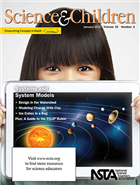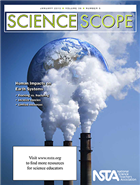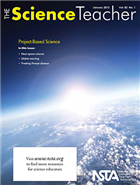January journals and SciLinks
By Mary Bigelow
Posted on 2015-01-17
One of the perks of being an NSTA member is having access to all of the journals online. Regardless of the grade level you teach, the journals have ideas for authentic activities and investigations that can be used, adapted, or extended for different levels of student interest and experience. Most are aligned with the NGSS.
This month, the article EQuIP-ped for Success appears in all three journals, describing a rubric with criteria on which to evaluate lessons and units and their alignment with the NGSS.
 Science & Children: Systems and System Models
Science & Children: Systems and System Models
Most of our students are familiar with the solar and metric “systems,” but any interaction of two or more things can be considered a system, and the resulting system can help us understand phenomena. This issue explores systems and the models used to understand them. Bill Robertson’s Science 101 column–How Should We Use the Concept of Systems?—is a good summary of the topic. And here are some SciLinks that provide content information and suggestions for additional activities and investigations related to this month’s featured articles:
- The Early Years: Exploring Systems [Systems]
- Formative Assessment Probes: Ice Cubes in a Bag [States of Matter]
- Teaching Through Trade Books: What’s the Big Idea About Bees? [Honey Bees, Pollination]
- Design in the Watershed [Watersheds, Water Quality]
- Printing the Playground [Engineering Structures]
- Virtual Modeling [Models]
- In the Watery World [Rivers and Streams, Water Quality, Invertebrates]
- Modeling Change With Clay [Landforms, Changes in the Earth’s Surface]
- Engineering Encounters: A System of Systems [Systems]
- Methods and Strategies: The Future of Farming [Plants as Food, Plant Growth]
 Science Scope: Human Impacts on Earth Systems
Science Scope: Human Impacts on Earth Systems
The featured articles explore the ever-threatening human impact on Earth systems. Get some ideas for student projects and investigations on the topic. Here are some SciLinks that provide content information and suggestions for additional activities and investigations related to this month’s featured articles:
- Aliens Invade and Drop Off Litter [Invasive Species]
- The Human Impact on Earthquakes: Natural Fracturing Versus Fracking [Earthquakes, Tectonic Plates, Predicting Earthquakes, Earthquake Measurement]
- Life With Limited Resources [Duckweed, Sustainable Development, Deforestation, Food Webs]
- No Space? Little Money? No Garden? Not So Fast! [Composting, Sustainable Agriculture]
- Plotting Plants [Invasive Species, Taxonomy]
- Tried and True: A Water Cycle of Many Paths [Water Cycle]
 The Science Teacher: Project-Based Science
The Science Teacher: Project-Based Science
Projects have come a long way from the days of gumdrop replicas of the atom! Working on projects provides students with ways of connecting and applying the content, practices, and concepts they are learning. The article Project-Based Science leads off this discussion. Here are some SciLinks that provide content information and suggestions for additional activities and investigations related to this month’s featured articles:
- The Green Room: Symbiotic Relationships [Symbiosis, Parasitism and Mutualism]
- Health Wise: Pardon me? Helping Students Avoid Noise-Induced Hearing Loss [Noise Pollution, Hearing]
- Near-Space Science: A Ballooning project to engage students with space beyond the big screen [Gas Laws, Kinetic Theory, Air Pollution]
- Global Warning [Climate Change, Global Warming]
- Treating Pompe Disease [Dominant and Recessive Traits, Enzymes]
- The Community Connection [Water Quality, Watersheds, Eutrophication]
Disclaimer: The views expressed in this blog post are those of the author(s) and do not necessarily reflect the official position of the National Science Teaching Association (NSTA).


